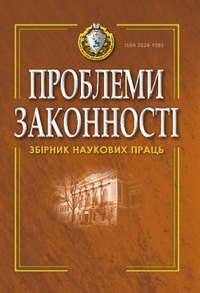Duplication of Harm in Tort Law
DOI:
https://doi.org/10.21564/2414-990x.151.215274Keywords:
causation, duplicated harm, successive causes, tort, injuryAbstract
The article addresses the issue of causation in cases where there are two successive events, each of which is sufficient to cause the same damage. Such cases are considered under the title ‘successive causes’ or ‘duplicated harm’. In such a scenario the issue arises: which of the two evens shall be considered as a legal cause of the damage. On the one hand, if the concept of damage denotes actual changes in the physical world, then each of the events can be considered as a cause of damage. However, if the concept of damage denotes economic losses (resulting from the changes in physical world), then only the first event can be considered as a cause of damage.
The author focuses on the cases involving harm to plaintiff’s health. The peculiarity of these cases is that the loss of earning capacity, in contrast to property damage, is continuous. Deciding on which of the two successive injuries shall be considered as a legal cause of the damage necessitates navigating through different tenets of tort law, which may contradict each other. Among those tenets there are: principle of full compensation (restitutio in integrum), ‘vicissitudes principle’, the principle that defendant ‘must take the victim as he finds him’ and ‘court does not speculate when it knows’. However, the paramount tenet is the principle of the full compensation, while other tenets must be seen as subsidiary.
The author analyzes English case law, in particular cases of Baker v. Willoughby and Jobling v Associated Dairies Ltd. Courts’ arguments are scrutinized.
Eventually the author argues in favor of the view that after the occurrence of the second incident the loss of earning capacity shall be considered as having two causes at the same time. This opens the way for the application of the regime of joint and several liability. Nevertheless, it should be borne in mind that injuries may and usually does cause moral damage as well. And the issue of compensating moral damage have to be contemplated separately.
References
Van Dam, C. (2013). European Tort Law (2nd ed.). Oxford University Press.
Borrowdale, A. (1983). Taking Account of Vicissitudes in the Assessment of Damages: An Anglo-Australian Perspective. The International and Comparative Law Quarterly, 32(3), 651–666.
Wagner, U. (1972). Successive Causes and the Quantum of Damages in Personal Injury Cases. Osgoode Hall Law Journal, 10(2), 369–397.
Quill, E. (2002). Successive Causes and the Measurement of Damages. Irish Jurist, 37, 91–112.
McInnes, M. (1997). Causation in Tort Law: Back to Basics at the Supreme Court of Canada. Alberta Law Review, 35(4), 1013–1034.
McGregor, H. (1970). Variations on an Enigma: Successive Causes of Personal Injury, Modern Law Review, 33(1), 378–390.
Fischer, D.A. (1999). Successive Causes and The Engima of Duplicated Harm. Tennessee Law Review, 66, 1127–1166.
King, J. (1981). Causation, Valuation, and Chance in Personal Injury Torts Involving Preexisting Conditions and Future Consequences. The Yale Law Journal, 90(6), 1353–1397.
Baker v. Willoughby. (1970). AC 467. URL: https://www.bailii.org/uk/cases/UKHL/1969/8.html.
Stene v. Evans. (1958). 14 D.L.R. (2d) 73 (Alta. S.C. (A.D.)). URL: https://www.canlii.org/en/ab/abca/doc/1958/1958canlii232/1958canlii232.html.
Long v. Thiessen. (1968). 65 W.W.R. 577 (B.C.C.A.). URL: https://www.canlii.org/en/bc/bcca/doc/1968/1968canlii889/1968canlii889.html.
Hicks v. Cooper. (1973). 1 O.R. (2d) 221 (C.A.). URL: https://www.canlii.org/en/on/onca/doc/1973/1973canlii1254/1973canlii1254.html.
Berns v. Campbell. (1974). 8 O.R. (2d) 680 (H.C.). URL: https://www.canlii.org/en/on/onsc/doc/1974/1974canlii641/1974canlii641.html.
Masson v. Rowan. (1988). 4 W.W.R. 430 (Man. Q.B.). URL: https://www.canlii.org/en/mb/mbqb/doc/1988/1988canlii7158/1988canlii7158.html.
Karnaukh, B.P. (2020). Nadlyshkova prychynnist u deliktnomu pravi [Overdetermined Causation in Tort Law]. Problemy zakonnosti – Problems of Legality, issue 150, 67–77. doi: https://doi.org/10.21564/2414-990x.150.209744 [in Ukrainian].
Jobling v Associated Dairies Ltd. (1982). AC 794. URL: https://www.bailii.org/uk/cases/UKHL/1981/3.html.
Performance Cars Ltd v. Abraham. (1962). 1 QB 33. URL: https://www.bailii.org/ew/cases/EWCA/Civ/1961/3.html.
L. (R.) v. Minister for Health and Children. (2001). IEHC 64; [2001] 1 IR 744 (6th April, 2001). URL: https://www.bailii.org/ie/cases/IEHC/2001/64.html.
Note to Baker v. Willoughby. (1969). Law Quarterly Review, 85, 307–310.
Downloads
Published
How to Cite
Issue
Section
License
Copyright (c) 2020 Богдан Петрович Карнаух

This work is licensed under a Creative Commons Attribution 4.0 International License.










